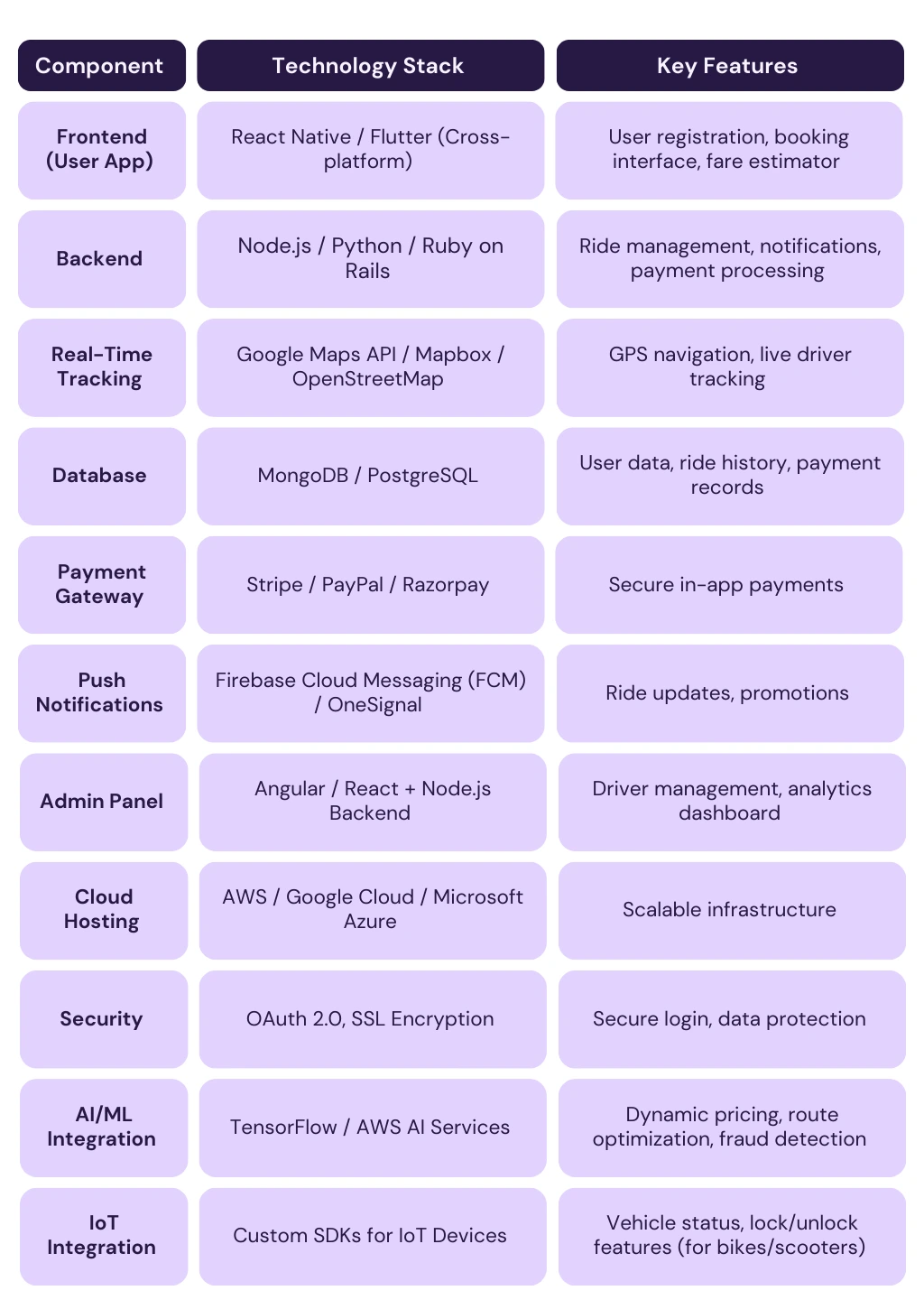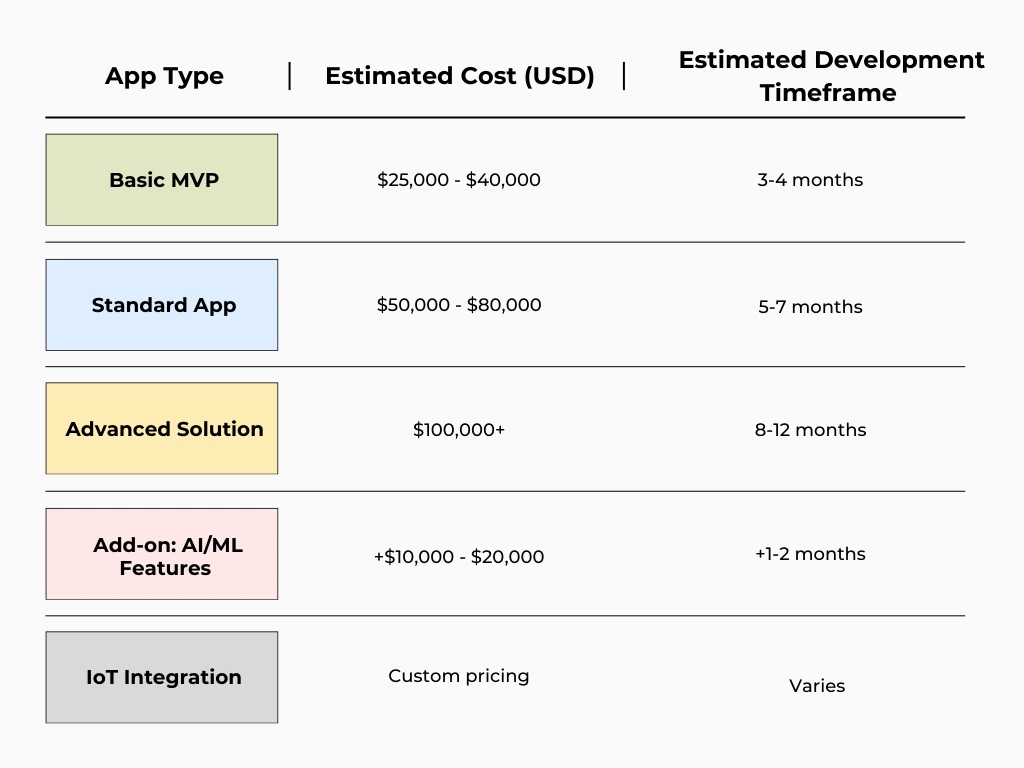
-
Apexlink
Real Estate
-
DLS
General Insurance
-
DMV
Government
-
Entiger
Fintech
-
GIS Mapping
Gas & Petroleum
-
HMS
Employee Benefit
-
HAWA
Government
-
Harley
Community
-
IHG
Hotel & Tourism
-
Sparkseeker
Humane Tech
-
Track Ninja
Sports
-
Response Vision
Disaster Management
- AI/ML Services
- Application Services
- Automation Services
- Cyber Security
- Chatbot Experts
- Data Analysis
- Data Warehouse Services
- Digital Commerce Services
- Digital Transformation
- Infrastructure Service
- Low Code/No Code
- Managed IT Services
- IT Support
- IT Consulting
- IT Outsourcing
- Mobile App Development
- IOS Development
- Android Development
- Cross Platform Development
- Gaming App Development
- Software Development
- System Design & Architecture
- Testing Services
- Web Development
Accelerators
POCs and Products
In an era being led by digital convenience and sustainability, ride-sharing apps have emerged as a cornerstone of modern urban mobility. From disrupting traditional taxi services to addressing environmental concerns, ride-sharing platforms like Uber, Lyft, and Didi have transformed how people commute. Yet, few realize that this revolution is not only transforming transportation but also creating lucrative business opportunities.
If you're considering where to channel your next tech investment, ride-sharing app development stands out as a future-proof choice. Here’s a comprehensive look at why now is the ideal time to invest and what makes this market so promising.
1. Explosive Market Growth and Future Potential
The global ride-sharing market has seen exponential growth over the past decade, and it's far from reaching its peak.
1.Market Size: According to Statista, the global ride-sharing market is projected to reach $212.75 billion by 2029, growing at a CAGR of 4.90% between 2025 and 2029.
2. User Adoption: Over 2.3 billion users are expected to use ride-sharing services by 2029.
3. Emerging Markets: Asia-Pacific, Latin America, and Africa are witnessing rapid urbanization, creating untapped opportunities for ride-sharing solutions.
As cities become smarter and personal vehicle ownership declines, demand for flexible, affordable transportation options will only increase.

2.Changing Consumer Behavior Favors Ride-sharing
Modern consumers prioritize cost-efficiency, convenience, and sustainability:
1.Shift from Ownership to Access: Millennials and Gen Z are less inclined to own cars, preferring on-demand mobility.
2. Eco-Conscious Choices: Shared rides reduce carbon emissions and traffic congestion, aligning with global sustainability goals.
3. Integration with Daily Life: Ride-sharing apps are no longer just for occasional use. As a matter of fact, they’re integrated into commutes, social outings, airport transfers, and even corporate travel.
This behavioral shift makes ride-sharing not just a trend, but a long-term lifestyle change.
3.Technological Advancements Driving Innovation
Investing in ride-sharing app development solutions today means leveraging cutting-edge technologies that enhance user experience and operational efficiency:
1.AI & Machine Learning: For dynamic pricing, route optimization, demand forecasting, and personalized user experiences.
2. IoT Integration: Real-time vehicle tracking, driver behavior monitoring, and predictive maintenance.
3. Blockchain: Secure transactions, transparent driver-partner payments, and decentralized data management.
4. Autonomous Vehicles: The future of ride-sharing is driverless. Companies like Uber and Tesla are already exploring autonomous fleets.
5. Electric Vehicles (EVs): Integration with EVs is helping platforms reduce operational costs and meet green energy standards.
Innovations like electric vehicle software development not only improve service quality but also open doors for differentiated offerings in a competitive market.
Building a competitive ride-sharing app requires a robust tech foundation. Here's a snapshot of the typical tech stack and essential features:


4.Diverse Revenue Models for Sustainable Profitability
Ride-sharing platforms benefit from multiple revenue streams, making them attractive from an investment standpoint:
1.Commission-Based Model: A percentage cut from each ride.
2.Surge Pricing: Increased fares during high-demand periods.
3. Subscription Plans: Offering users discounted rates for monthly memberships.
4. Corporate Tie-ups: Providing ride solutions for businesses.
4. In-App Advertisements: Monetizing app traffic.
5. Vehicle Leasing & Rentals: Offering vehicles to drivers on lease.
6. Micro-Mobility Integration: E-scooters, bike riding apps, and carpooling options expand service offerings.
A well-structured app can unlock recurring revenue while scaling across geographies and services.
5.Opportunities in Niche and Localized Markets
While global giants dominate in some regions, there's significant room for regional and niche-specific ride-sharing apps:
1.Rural and Semi-Urban Mobility Solutions
2.Women-Only Ride-sharing Services for safety and comfort.
3. Corporate Ride-sharing Platforms to optimize employee transportation.
4. Healthcare Transport for patient mobility.
5. Eco-Friendly Ride Services focusing on EV fleets.
Tailoring your ride-sharing app to specific audiences or regions enables you to tap into underserved market segments overlooked by global giants.
Seasia’s E-Scooter App Success
At Seasia Infotech, we've seen firsthand how tailored mobility solutions can succeed. We developed an e-scooter ride-sharing app for a client to help them tap into the booming micro-mobility market by offering an eco-friendly, app-based scooter rental service.
The result?
1.30% increase in user adoption within 3 months
2.Seamless integration of real-time GPS tracking, IoT-enabled scooters, and cashless payments
This proves that whether it's cars, bikes, or scooters, smart, localized e-scooter application development delivers strong ROI.

6. Government Support & Smart City Initiatives
Many governments are promoting ride-sharing as part of their smart city and sustainability initiatives:
1.Tax incentives for EV-based ride-sharing fleets.
2. Policies encouraging reduced private vehicle usage.
3. Partnerships with ride-sharing companies to improve urban mobility infrastructure.
Such supportive regulations significantly reduce investment risks and enhance long-term viability.
7. Scalability and Expansion Potential
Ride-sharing apps are inherently scalable:
1.Geographical Expansion: Once core infrastructure is set, expanding to new cities or countries is seamless.
2. Service Expansion: Add-ons like food delivery, package transport, or logistics services can be integrated using the same platform.
3. Cross-Platform Synergies: Integrate your ride-sharing service with payment wallets, loyalty programs, or tourism apps for broader engagement.
This flexibility ensures long-term growth beyond just rides.
8. Improved Safety and Compliance Technologies
Modern ride-sharing apps come equipped with advanced safety features:
1.Real-time tracking and SOS buttons.
2. Driver background verification through AI-based checks.
3. Compliance with GDPR and local data protection laws.
4. In-app insurance options for riders and drivers.
Robust safety features are no longer optional; they are a critical differentiator that fosters user trust and brand loyalty.
9.Cost-Effective Development Options
With advancements in app development frameworks and availability of white-label solutions, entering the ride-sharing market has become more accessible:
1. MVP Development: Test your idea with a Minimum Viable Product before full-scale investment.
2. Cross-Platform Development: Use frameworks like Flutter or React Native to build for both iOS and Android cost-effectively.
3. Cloud Infrastructure: Scalable backend solutions reduce upfront infrastructure costs.
Partnering with an experienced app development company like Seasia Infotech ensures you get a secure, scalable, and feature-rich product while maximizing RoI.
How to Start Building Your Ride-Sharing App
Follow these strategic steps to launch your ride-sharing app:
1. Identify gaps in existing services, analyze your competition, and clearly define your target audience through market research.
2. Craft a user-centric design with intuitive UI/UX that maximizes engagement and minimizes friction.
3. Choose robust and scalable technologies like Node.js, React Native, and cloud platforms such as AWS or Google Cloud to ensure performance and scalability.
4. Build an MVP first, gather user feedback, and iterate to enhance features based on real-world testing.
5. Conduct thorough testing, including performance, usability, security, and real-time scenarios to ensure seamless operation.
6. Implement a strong marketing strategy leveraging SEO, social media, and influencer partnerships to reach your target audience effectively.
Successful Ride-sharing Apps to Learn From
1.Uber: With presence in over 70 countries, Uber has set industry standards with its extensive features and user-centric approach.
2. Lyft: Distinguished by a strong community vibe, Lyft emphasizes friendliness and trust, building a loyal user base.
3.E-Scooter App: Successfully integrating eco-friendly travel solutions with ride-sharing, the E-Scooter app developed by Seasia Infotech has capitalized on the growing demand for sustainable transport.
How Much Does Ride-sharing App Development Cost?
The cost of developing a ride-sharing app depends on several factors like features, technology stack, design complexity, geographic deployment, and developer rates.
Here’s a rough breakdown:

Key Cost Factors:
1. Platform Choice: iOS, Android, or Cross-platform
2. Custom vs. White-label Solutions
3. Third-party API Integrations
4. Post-launch Support & Maintenance

Final Thoughts
Investing in ride-sharing app development isn’t just about tapping into a booming market, it’s also about shaping the future of urban mobility, sustainability, and digital convenience. With growing consumer demand, technological innovations, and diverse monetization strategies, the potential returns are significant.
Whether you're targeting a global audience or focusing on niche markets, now is the perfect time to accelerate your entry into this dynamic industry.
Thinking of Developing a Ride-sharing App?
Partner with experts who understand the nuances of mobility solutions. From concept to launch, and beyond, skilled ride-sharing app developers at Seasia Infotech ensure your app stands out in a competitive market.
Frequently Asked Questions
1. What legal and regulatory challenges should I consider for a ride-sharing app?
Compliance with local transportation laws, licensing, insurance requirements, data protection regulations (like GDPR), and safety standards are essential. Working closely with legal experts is recommended to navigate these challenges effectively.
2.How much does it cost to develop a ride-sharing app?
App development costs range significantly depending on complexity, features, and platform. Typically, the cost can range from $50,000 to over $200,000. Creating an MVP first can optimize costs and streamline the development process.
3.What role does GPS and real-time tracking play in ride-sharing apps?
GPS and real-time tracking are foundational for route optimization, accurate ride ETAs, enhanced safety features, and efficient fleet management. It significantly improves user satisfaction and operational efficiency.
4.Can I build a ride-sharing app without coding?
Yes, using low-code/no-code development platforms like Bubble or Glide allows basic app creation without extensive coding. However, these platforms have limitations in customizability, scalability, and integrating advanced features like AI-driven analytics and complex backend management.
5.How can AI and machine learning improve ride-sharing apps?
AI and ML improve app efficiency by predicting user behavior, optimizing routes, dynamic pricing, automating customer support, and enhancing security through fraud detection. Leveraging AI also enables personalized experiences, significantly boosting user satisfaction.







 Blockchain
Blockchain Cloud Computing
Cloud Computing Infrastructure
Services
Infrastructure
Services Metaverse
Metaverse QA
Automation
QA
Automation UI/UX
UI/UX







